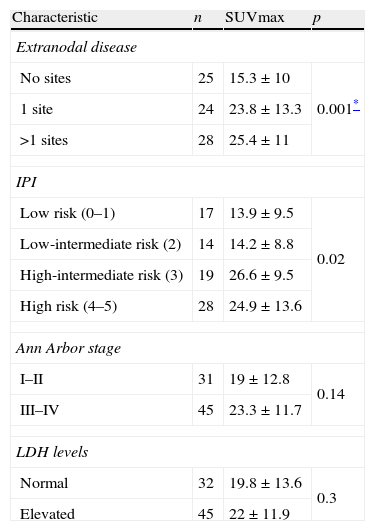The aim of this study was to evaluate whether the maximum standardized uptake value (SUVmax) of 18F-fluorodeoxyglucose (FDG) correlates with the International Prognostic Index (IPI) and the presence of extranodal involvement in patients with Diffuse Large B-Cell Lymphoma (DLBCL).
Material and methods77 patients (age: 57.2±18.5, 40F, 37M) with DLBCL who underwent FDG PET/CT for initial staging were included. SUVmax of the predominant lesions were compared to Ann Arbor stage, IPI scores, the presence of extranodal involvement and the number extranodal sites.
ResultsPET/CT detected nodal (n:25) and extranodal involvement (n:52) in all the patients. In 27 patients, extranodal disease could only be detected by PET. SUVmax of the predominant lesion in patients with extranodal disease was significantly higher than that of the patients who had only nodal disease (25±12 vs. 15.3±10 respectively, p=0.001). SUVmax significantly correlated with IPI scores; the average SUVmax was significantly correlated with the IPI: Mean SUVmax of the predominant lesion was 13.9±9.5 in patients with low risk (IPI=0–1), 14.2±8.8 in low-intermediate risk group (IPI=2) whereas 26.6±9.5 in high-intermediate risk group (IPI=3) and 25±13.6 in high risk group patients (IPI=4–5) (p=0.002). SUVmax was not correlated with clinical stage, the number of extranodal sites and serum LDH levels.
ConclusionFDG uptake correlates with IPI and the presence of extranodal involvement in DLBCL. PET is a powerful method to detect extranodal disease in DLBCL. The correlation of SUVmax with these prognostic factors may highlight the importance of pretreatment FDG uptake as a metabolic marker of poor prognosis for patients with DLBCL.
El objetivo de este estudio fue evaluar si el valor estandarizado de captación máximo (SUVmáx) de 18F-fluorodesoxiglucosa (FDG) se correlaciona con el índice pronóstico internacional (IPI) y la presencia de afectación extranodal en pacientes con linfoma B difuso de células grandes (LBDCG).
Material y métodosSe incluyeron 77 pacientes (40H, 37M; edad: 57,2±18,5años) con LBDCG a los que se efectuó 18F-FDG PET/TAC para la estadificación inicial. Se correlacionó el SUVmáx de las lesiones predominantes con el estadio Ann Arbor, las puntuaciones IPI y la presencia y número de sitios de afectación extranodal.
ResultadosLa PET/TAC detectó afectación ganglionar (n:25) y/o extranodal (n:52)en todos los pacientes. En 27 la enfermedad extraganglionar solo fue detectada por la PET. El SUVmáx de la lesión predominante en los pacientes con enfermedad extraganglionar fue significativamente mayor que el de los pacientes que solo tenían enfermedad ganglionar (25±12 frente a 15,3±10, respectivamente; p=0,001). El SUVmáx se correlacionó significativamente con el IPI: el SUVmáx medio de la lesión predominante fue de 13,9±9,5 en pacientes con bajo riesgo (IPI=0–1); 14,2±8,8 en el grupo de riesgo bajo-intermedio(IPI=2), por 26,6±9,5 en el grupo de alto riesgo intermedio (IPI=3) y, finalmente, 25±13,6 en el grupo de pacientes de alto riesgo (IPI=4–5) (p=0,002). El SUVmáx no se correlacionó con el estadio clínico, el número de sitios extraganglionares ni los niveles de LDH en suero.
ConclusiónUna captación de FDG alta se correlaciona con IPI elevado y presencia de afectación extranodal en el LBDCG. La PET es un método poderoso para detectar enfermedad extranodal en LBDCG. La correlación del SUVmáx con estos factores pronósticos puede poner de manifiesto la importancia de la captación de FDG pretratamiento como un marcador metabólico de pobre pronóstico en los pacientes con LBDCG.
Artículo
Comprando el artículo el PDF del mismo podrá ser descargado
Precio 19,34 €
Comprar ahora










